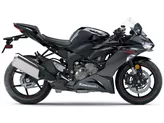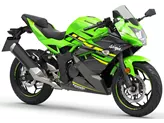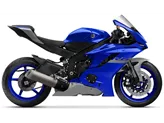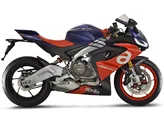Yamaha YZF-R6 2019 vs. Kawasaki Ninja ZX-6R 2019

Yamaha YZF-R6 2019

Kawasaki Ninja ZX-6R 2019
Visão geral - Yamaha YZF-R6 2019 vs Kawasaki Ninja ZX-6R 2019
The Yamaha YZF-R6 2019 and the Kawasaki Ninja ZX-6R 2019 are both supersport motorcycles that offer high performance and advanced features.
Starting with the Yamaha YZF-R6 2019, it is powered by an inline four-cylinder engine with a displacement of 599cc. It produces a power output of 118 HP and a torque of 65.7 Nm. The engine has a high compression ratio of 13.1, which contributes to its performance. The bike features a DOHC valve system with four valves per cylinder.
In terms of suspension, the Yamaha YZF-R6 2019 is equipped with a telescopic upside-down fork at the front with a diameter of 43mm. The suspension can be adjusted for compression, preload, and rebound. At the rear, it has a swingarm suspension with a monoshock that also offers adjustability. The chassis of the bike is made of aluminum and features a Deltabox frame, which provides a rigid and lightweight structure.
The Yamaha YZF-R6 2019 is equipped with dual disc brakes at the front with a diameter of 320mm. The brakes use radial technology for improved performance. The bike also features advanced rider assistance systems such as ABS, multiple riding modes, ride-by-wire throttle control, and traction control.

Yamaha YZF-R6 2019
Moving on to the Kawasaki Ninja ZX-6R 2019, it is also powered by an inline four-cylinder engine, but with a larger displacement of 636cc. It produces a higher power output of 130 HP and a torque of 70.8 Nm. The engine has a slightly lower compression ratio of 12.9. Similar to the Yamaha, it also features a DOHC valve system with four valves per cylinder.
In terms of suspension, the Kawasaki Ninja ZX-6R 2019 is equipped with a telescopic upside-down fork at the front with a diameter of 41mm. The suspension can be adjusted for compression, preload, and rebound. At the rear, it has a swingarm suspension with a monoshock that offers adjustability. The chassis of the bike is made of aluminum and features a dual tube, perimeter, extruded frame, which provides a balance between rigidity and flexibility.
The Kawasaki Ninja ZX-6R 2019 is equipped with dual disc brakes at the front with a diameter of 310mm. The brakes also use radial technology for improved performance. Similar to the Yamaha, it also features advanced rider assistance systems such as ABS, multiple riding modes, ride-by-wire throttle control, and traction control.
In terms of dimensions, both bikes have the same width and diameter for the front and rear tires. The Yamaha YZF-R6 2019 has a slightly shorter wheelbase of 1375mm compared to the Kawasaki Ninja ZX-6R 2019 with a wheelbase of 1400mm. The seat height of the Yamaha is 850mm, while the Kawasaki has a slightly lower seat height of 830mm. Both bikes have a fuel tank capacity of 17 liters.
In terms of strengths, the Yamaha YZF-R6 2019 has a top-notch chassis that offers tight and sporty handling. It also features powerful brakes from the YZF-R1 model and has a modern LED lighting system. The bike comes with a mature electronic package and a clear and easy-to-read display. The engine is highly responsive and offers a thrilling performance.

Kawasaki Ninja ZX-6R 2019
On the other hand, the Kawasaki Ninja ZX-6R 2019 has a great engine with a balanced mix of revs and torque. It offers a super sporty riding pleasure with lively handling. The bike has a responsive front fork and a decent and adjustable chassis.
In terms of weaknesses, the Yamaha YZF-R6 2019 could have a bit more power in the mid-range of the revs. It also has a clear price difference compared to the Kawasaki, but this can be justified by its features and performance.
The Kawasaki Ninja ZX-6R 2019 has some minor details that could be more refined, such as the license plate holder and turn signals. The overall silhouette of the bike is not aggressive enough for a sports motorcycle.
In conclusion, both the Yamaha YZF-R6 2019 and the Kawasaki Ninja ZX-6R 2019 are high-performance supersport motorcycles with advanced features. The Yamaha offers a top-notch chassis and powerful brakes, while the Kawasaki has a great engine and lively handling. Both bikes have their strengths and weaknesses, and the choice between them would depend on personal preferences and priorities.
Especificações técnicas Yamaha YZF-R6 2019 em comparação com Kawasaki Ninja ZX-6R 2019
Prós e contras em comparação
Prós e contras em comparação
Yamaha YZF-R6 2019

Quase parece que a Yamaha YZF-R6 nasceu na pista de corrida. É fácil perceber que a R6 é a irmã mais nova da YZF-R1. Quer seja no design, na ergonomia, na travagem ou nas ajudas electrónicas - os genes das corridas estão por todo o lado! A R6 é uma excelente peça de engenharia na classe de 600cc e, dependendo das suas preferências, é provavelmente a melhor moto de 600cc atualmente disponível - pelo menos para a pista de corridas. A Yamaha proporciona ao condutor uma precisão e um feedback incrivelmente elevados sobre a roda dianteira e o chassis, ao mesmo tempo que é super manejável! O motor é extremamente rápido, mas também quer ser mantido feliz. É uma pena que a última versão da R6 tenha perdido alguma da sua potência devido ao Euro 4... No entanto, será a moto de pista mais rápida para a maioria de nós. E, se for necessário, um sistema de escape aberto (sem homologação para estrada) e um mapeamento podem fazer cócegas em mais alguns cavalos de potência da super desportiva. Um design elegante e componentes ainda mais elegantes - TOP!
Kawasaki Ninja ZX-6R 2019

A Kawasaki Ninja ZX-6R é uma mota supersport de tamanho perfeito. Com os seus 130 cv, é possível uma condução desportiva mas controlada. As mudanças mais curtas e a cilindrada extra de 36 cc garantem que pode ser um pouco mais preguiçoso na estrada. Uma digna porta-bandeira para o segmento das superdesportivas de 600 cc.
Comparação de preços Preço médio de mercado Yamaha YZF-R6 vs Kawasaki Ninja ZX-6R
There are a few key differences between a Yamaha YZF-R6 2019 and a Kawasaki Ninja ZX-6R 2019. It takes less time to sell a Yamaha YZF-R6 with 140 days compared to 160 days for a Kawasaki Ninja ZX-6R. Since model year 2005 1000PS.de editors have written 33 reviews for the Yamaha YZF-R6 and 37 reviews for the Kawasaki Ninja ZX-6R since model year 2005. The first review for the Yamaha YZF-R6 was published on 17/10/2002 and now has more than 3 600 views. This compares to more than 5 800 views for the first review on Kawasaki Ninja ZX-6R published on 02/09/2002.




















